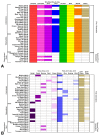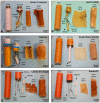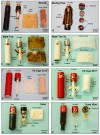Design Features in Multiple Generations of Electronic Cigarette Atomizers
- PMID: 31416115
- PMCID: PMC6720609
- DOI: 10.3390/ijerph16162904
Design Features in Multiple Generations of Electronic Cigarette Atomizers
Abstract
The design of electronic cigarette (EC) atomizing units has evolved since their introduction over 10 years ago. The purpose of this study was to evaluate atomizer design in ECs sold between 2011-2017. Atomizers from 34 brands representing three generations of ECs were dissected and photographed using a stereoscopic microscope. Five distinct atomizer design categories were identified in first generation products (cig-a-like/cartomizer) and three categories were found in the third generation. Atomizers in most cig-a-like ECs contained a filament, thick wire, wire joints, air-tube, wick, sheath, and fibers, while some later models lacked some of these components. Over time design changes included an increase in atomizer size; removal of solder joints between wires; removal of Polyfil fibers; and removal of the microprocessor from Vuse. In second and third generation ECs, the reservoirs and batteries were larger, and the atomizing units generally lacked a thick wire, fibers, and sheath. These data contribute to an understanding of atomizer design and show that there is no single design for ECs, which are continually evolving. The design of the atomizer is particularly important as it affects the performance of ECs and what transfers into the aerosol.
Keywords: atomizer; cig-a-like; clearomizer; design features; e-cigarette; electronic cigarette; mods.
Conflict of interest statement
The authors declare no conflicts of interest.
Figures





References
-
- Banga B. Global E-Cigarette and T-Vapor Market to Reach $86.43 Billion by 2025, Reports BIS Research. [(accessed on 7 February 2019)]; Available online: https://www.prnewswire.com/news-releases/global-e-cigarette-and-t-vapor-....
-
- Martin T. 4 Facts You Need to Know About E-Cigarettes. [(accessed on 23 January 2019)]; Available online: https://www.verywellmind.com/facts-about-e-cigarettes-2825261.
-
- Stratton K., Kwan L.Y., Eaton D.L., Health P., Practice P.H., Division M. Public Health Consequences of E-Cigarettes. National Academies Press; Washington, DC, USA: 2018.

